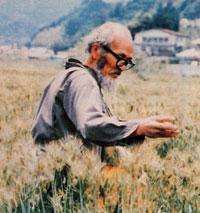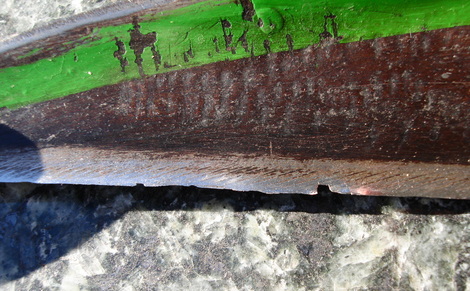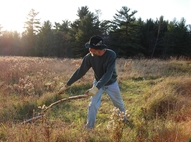 Yes, the "One Scythe Revolution" is an allusion, in part, to Masanobu Fukuoka's classic The One-Straw Revolution. Back in 1984, I attended a conference with Frances Moore Lappe, and this documentary was shown there. Up until then, my life's ambition had been to be an artist. After seeing this documentary, I was inspired to take a little detour, and become a Natural Farmer, and then do my art in all my free time, once Nature started doing most of the work. This turned out to be harder than it looks! I'm still working at it, but I think that the scythe could make Natural Farming work here in temperate climates. I hope to be writing more about that in future posts.
0 Comments
The winter grains are thigh high already. Time to finally figure out a homemade grain cradle, of some sort. Here are a couple of ideas, from wildseed01 on YouTube. Thanks Wildseed01 for sharing this good info! Below is a simple bow cradle (boyle) with a pricker. See 0:54 for still picture. This one can be completely homemade with some green willow, a thin angle iron, and some good twine. In The Scythe Book, Tresamer talks about the tremendous diversity of plants that old-time pastures and hay fields used to have, and he also briefly mentions how farmers used to make special herbal hay with their scythes, for the health of their animals, and ultimately themselves. Here in this video below, a mountain farmer from Murau, Austria, explains the optimal stage at which to cut an herbal meadow, for the first cutting of hay, for maximum herbal strength and mineral content. She also talks about the healing properties of some of the herbs, and how much her cows enjoy and benefit from them. Modern fields have much less diversity, which is why she heads up high into the mountain to cut the old hayfields that mechanised farming hadn't adulterated. As for timing the first cut, conventional wisdom now is that the best time to mow for hay, is before the grass has started to head out, because it has the most protein at this stage. But from what I've read in old German scythe literature, the traditional time to mow the first cutting was "when the meadow is in bloom", as Maria Berger (Women's World Scythe Champion in 2000) is explaining in the video. Usually around St. John's Day, which is close to the summer solstice. Also happens to coincide with the longest day length of the year, for the quickest drying time of this massive volume of hay. To everything there is a season. I sometimes peen scythe blades for local scythe people that don't want to peen their own. I see a lot of damaged edges doing this. Most damage occurs when the blade is dull and the owner compensates for that by swinging harder and chopping at the grass. The leverage on the tip of the blade from this force, often pushes the tang to the back of the ring, which opens up the tang angle all the way, and then the full force of the blow hits the edge of the blade straight on, instead of the acute shearing angle it was meant to. If the edge hits a rock straight on like this, you can cause considerable damage, as shown in the picture above. If you keep mowing with this kind of a crack, the crack can snag on an object, and increase the damage.
|
Botan AndersonArchives
March 2023
Categories
All
|


 RSS Feed
RSS Feed